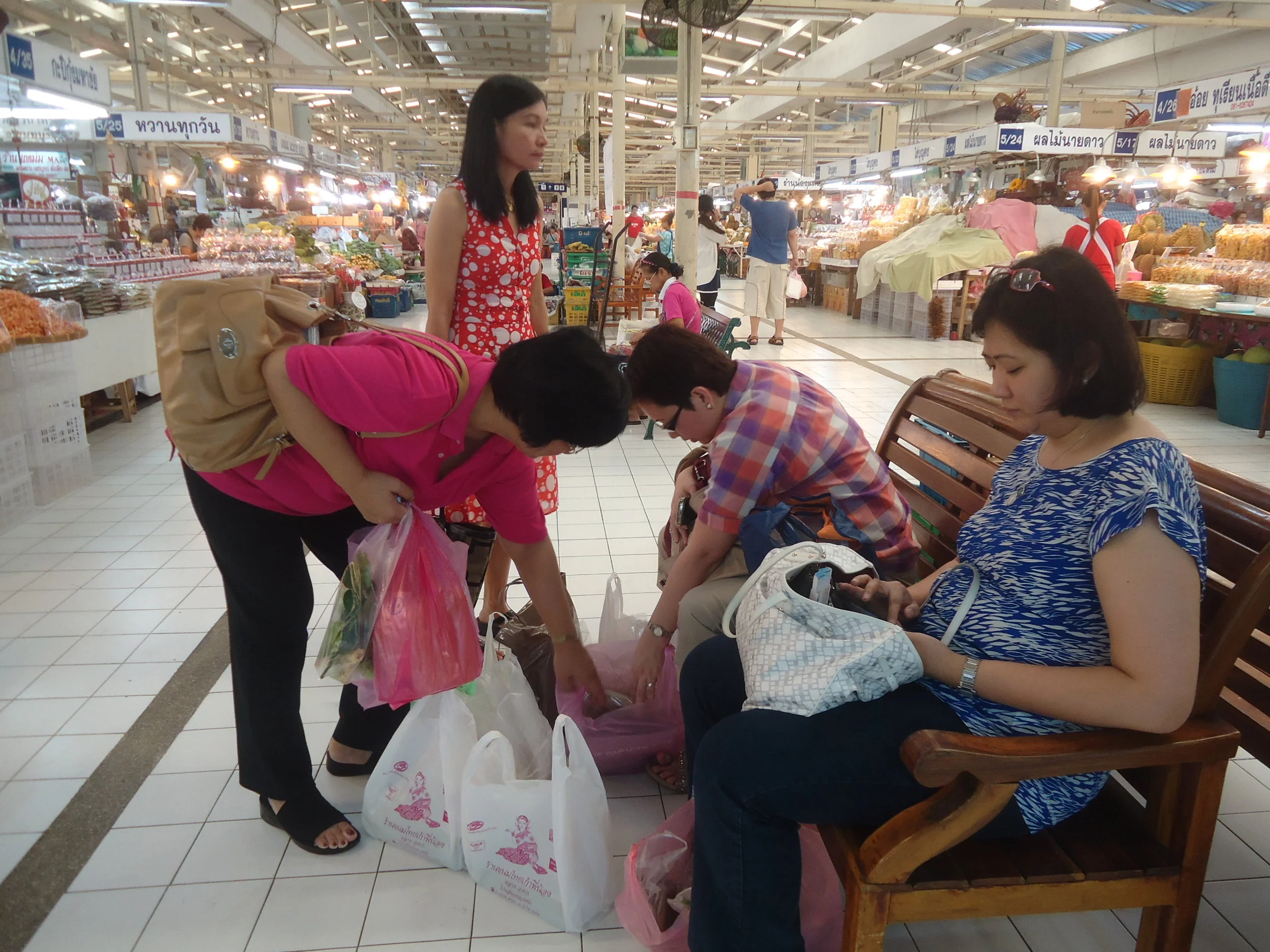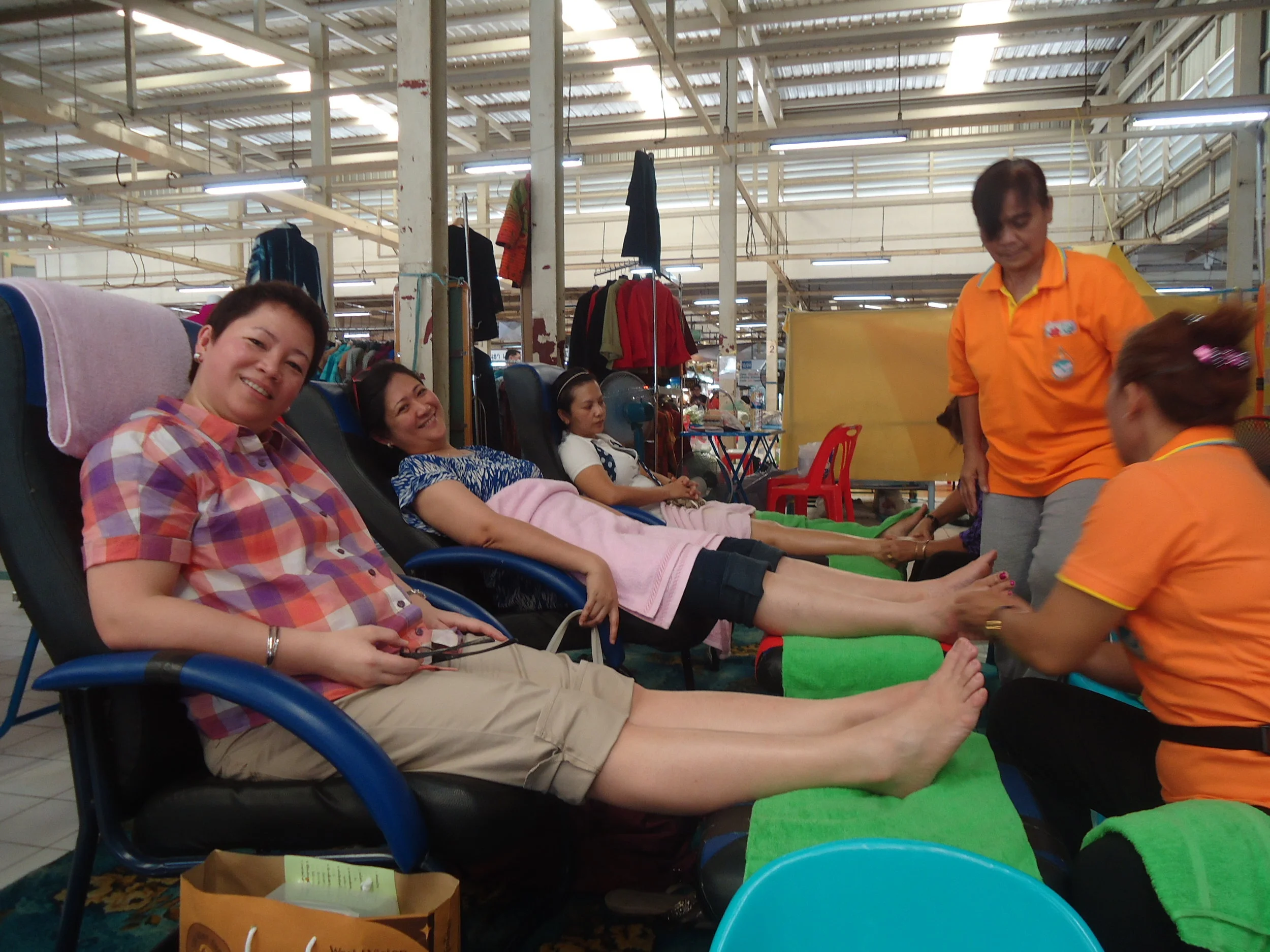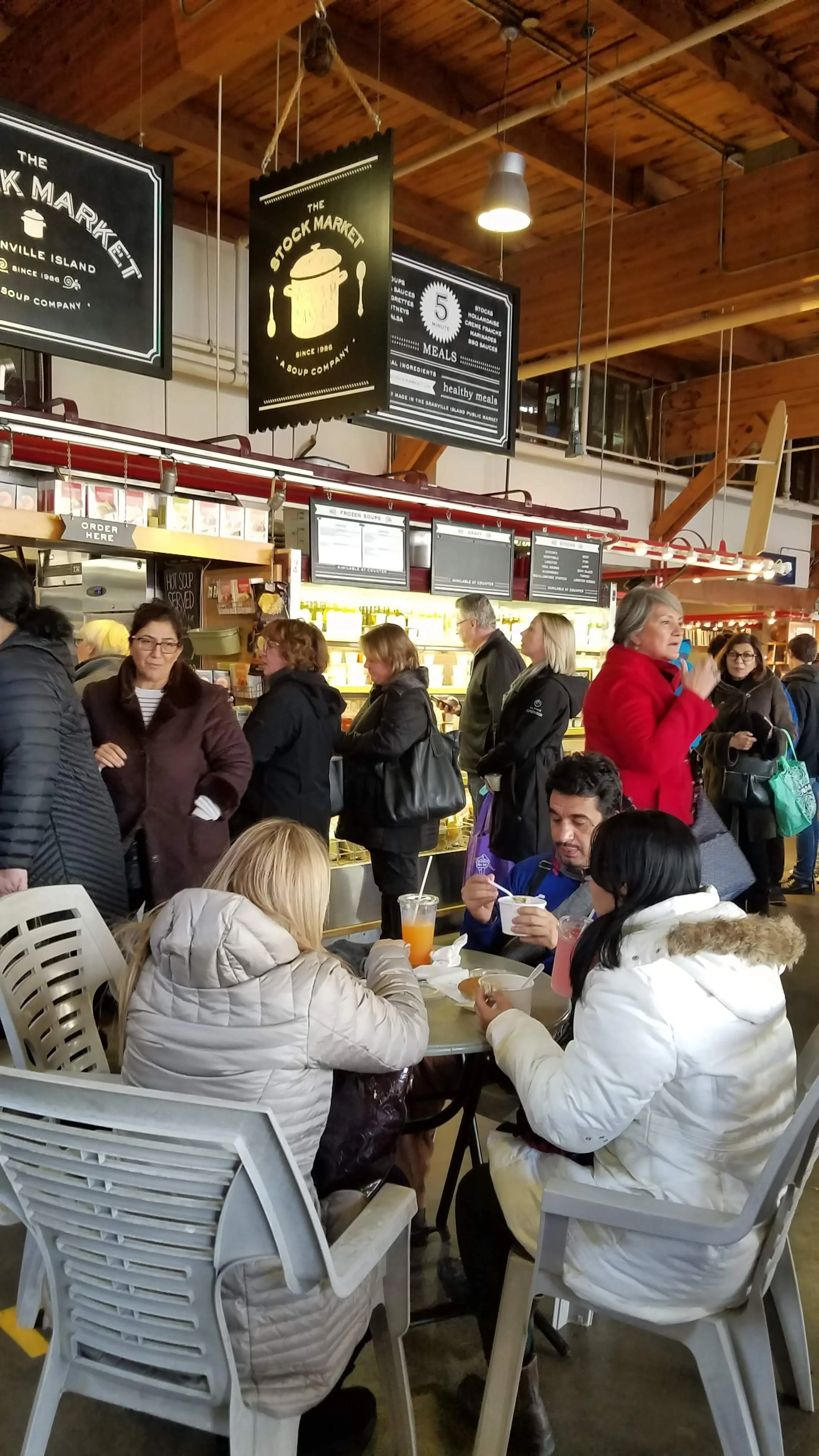Provide Places to Sit, Places to Eat
“In the middle of the market is the large common court-like area surrounded by eateries that serve everything from pork sandwiches to pizzas. Large white Formica tables pushed together encourage strangers to sit and eat together. Between bites they look things over, perhaps staring in the face of a complete stranger or making casual, if accidental eye contact with the next person. Whether they look down or away, an identity emerges to be established or truncated, depending on whether either party interprets the exchange of looks as an invitation to conversation. In this public place people can take up others’ opening gambits or not, as they choose. In this setting strangers engage one another about the personal details of their lives.”
READING TERMINAL MARKET, PHILADELPHIA
IMAGES AROUND THE FOOD HALL
Reading Terminal Market
Interactive map where yellow colored blocks with white dots indicate seating areas [7]
In a study by the Project for Public Spaces for the Ford Foundation, 28% of respondents identified that the most important benefit of a market was its ability to bring people together [4]. In planning food halls, one must remember that they are not just places to eat. Instead, they are places where members of the community can go shopping, hanging out, observing, and meeting other people [1, 2, 4, 8, 10].
GRANVILLE PUBLIC MARKET
IMAGES OF PEOPLE OBSERVING, SOCIALIZING, AND BUYING FOOD
Places to Sit
Successful public places provide places to sit. These enable people to hang out and observe others, to rest, and to chat with other people. Whyte studied public spaces in New York City and noted that the amount of space available for sitting increased the usage of the building plazas [9]. The nonprofit group Project for Public Places identified “places to sit” as an essential factor in establishing comfort in public places [6]. A Rowntree Foundation study on social interaction in public spaces developed case studies on the design of benches. The study pointed out that benches with no backs, for example, discouraged eating or hanging out. A study on markets as sites for social interaction pointed out that successful markets had lots of places to sit [8]. In maximizing inclusion, providing places to sit will ensure comfort for members of the community who need special assistance, like the elderly, the disabled, and women who are caring for children.
GRANVILLE PUBLIC MARKET
VARIOUS TYPES OF OUTDOOR SEATING WHICH MAXIMIZES VIEWS OF THE WATER
Places to Eat
Being able to sit down to eat encourages people to stay longer in public places. Being able to sit down to eat encourages conversations too [2, 8]. Public markets which provide prepared foods and places where to comfortably eat, expand the number of people who visit, the length of time that they stay, and their opportunities for social interaction.
Historically, public places which have thrived involved places where people sat down to eat and converse, like street side eating places in China, medieval inns in the United Kingdom, coffee houses in the Middle East, and the irregularly shaped outdoor plazas in Europe [3, 5] Food halls and food markets are good examples of public spaces which provide members of the community a place to gather and interact with each other.
Around the world, there are similarities and variations, in terms of places for sitting, eating, and resting in food halls.
Market! Market! Food Hall, Bonifacio Global City, Philippines
Cafeteria style seating for food hall diners
The Market! Market! food hall in a central business district near Makati, Philippines provides plentiful, durable, easy to clean, and efficiently laid out seating to accommodate a large number of shoppers and office workers coming in for lunch. The food hall itself is housed in a large open-air structure, providing shade against the noon-day sun while also bringing in the breeze for natural ventilation.
Newton Hawker’s Market, Singapore
Cafeteria style seating for diners
The Newton Hawker’s Market in Singapore has a similar structure which is designed for a tropical climate. The structure has high ceilings and open-air pavilions housing both the food stalls and seating for the diners. The seating is simple, laid out efficiently, easy to clean, and durable.
Or Tor Kor Food Market, Bangkok
Comfortable bench seating allows for reconvening, rest, and sorting after a morning of shopping for souvenir food items
The Or Tor Kor food market in Bangkok sells fresh produce, prepared meals, and artisanal food souvenir items. Strategically located benches along the corridors provide for comfortable places to wait for one’s companions and to sort out and compare one’s purchases with each other.
Or Tor Kor Food Market, Bangkok
Even more comfortable type of seating, allowing for a combination of food shopping, dining, and the traditional Thai foot massage
The Or Tor Kor Market in Bangkok expands the idea of comfortable seating by providing stalls where customers can rest, enjoy a foot massage, while at the same time chatting with their fellow shoppers.
Granville Public Market, Vancouver
Outdoor picnic tables encourage appreciation of the Vancouver bay view
In Vancouver’s Granville Market, outdoor eating spots are prime areas to enjoy the rare display of sunshine in the city. These eating spots are strategically located in the outdoor sections of the market with a view and connection to the water.
Granville Public Market, Vancouver
Outdoor benches encourage hanging out and appreciation of the Vancouver bay view
Bench seating around the Granville Public Market encourages multiple types of users… visitors and residents who are enjoying beautiful views of the marina, diners who opt to have their meals outdoors, and passersby who are just walking along the promenade.
Granville Public Market, Vancouver
Moveable chairs and tables allow for maximum flexibility for indoor diners
Inside the Granville market central dining area, chairs and tables are moveable. This arrangement allows for maximum flexibility in accommodating different group sizes.
Food halls and markets help bring residents of the community together, encouraging familiarity and social interaction. Successful food halls provide comfortable and plentiful places to sit and eat, thereby increasing its visitors, expanding the length of time that they stay, and allowing the residents more opportunities to interact with each other comfortably.
Sources:
Elijah Anderson, The Cosmopolitan Canopy: Race and Civility in Everyday Life (New York, New York, W.W. Norton & Co., c 2011. 1st ed.).
'Food Halls of North America', (Cushman & Wakefield, 2018).
Karen Franck, 'The City as Dining Room, Market, and Farm', Architecture Design May/June 2005.
'Making Your Market a Dynamic Community Place', (Project for Public Spaces, 2016).
Susan Parham, 'Designing the Gastronomic Quarter', Architecture Design, May/June 2005.
'Placemaking and the Future of Cities', (Project for Public Spaces, Inc. under the auspices of the UN-HABITAT Sustainable Urban Development Network (SUD-NET), 2012).
'Reading Terminal Market: Interactive Map', 2019 <https://readingterminalmarket.org/interactive-map/>.
David Studdert and Sophie Watson, Markets as Sites for Social Interaction: Spaces of Diversity, Public Spaces Series (Bristol, UK, Published for the Joseph Rowntree Foundation by Policy Press, 2000).
William Hollingsworth Whyte, The Social Life of Small Urban Spaces (Washington, D.C, Conservation Foundation, 1980).
Tad Wilkes, 'Food Halls and Markets Still on-Trend ', in Hotel F&B (2017).

















